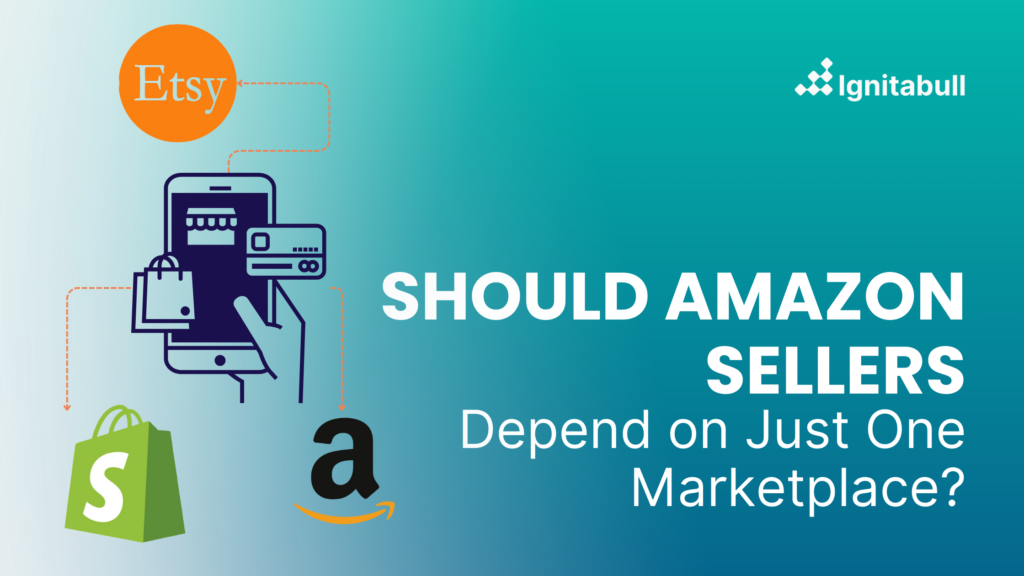
In the world of e-commerce, Amazon dominates as a top marketplace for businesses. With over 3.2 billion active customer accounts and more than 200 million Prime members globally, it’s easy to see why many sellers rely on Amazon as their primary platform. However, is putting all your eggs in the Amazon basket the best strategy?
This blog explores the risks of depending solely on Amazon and the benefits of diversifying your sales channels to include platforms like Shopify, Walmart Marketplace, and others.
The Risks of Relying Exclusively on Amazon
- Algorithm Dependency
Amazon’s A9 algorithm dictates product visibility, meaning any change in its ranking factors can significantly impact your sales. A tweak in policy, new ad placement rules, or increased competition can leave sellers scrambling to adapt. - Fee Increases
Amazon takes a cut of every sale through referral fees, fulfillment fees (if you use FBA), and other charges. Over the years, these fees have steadily increased, eating into sellers’ profit margins. By relying solely on Amazon, sellers expose themselves to these rising costs without alternatives to offset them. - Account Suspensions
Amazon’s strict compliance policies can lead to account suspensions for issues like counterfeit claims, listing violations, or late shipments. Many sellers have experienced the devastating effect of losing access to their primary revenue stream overnight. - Limited Customer Ownership
When you sell on Amazon, the platform owns your customer data, not you. This limits your ability to build a direct relationship with your audience through targeted marketing, such as email campaigns, which are key for long-term growth.
The Case for Diversification
Diversifying your sales channels allows you to build a more robust and sustainable business model. Here’s how:
- Shopify: A Direct-to-Consumer Powerhouse
Shopify enables sellers to build their own e-commerce store, giving them full control over branding, customer data, and marketing strategies. With Shopify, you can implement SEO services and personalized marketing campaigns that would be impossible on Amazon. - Walmart Marketplace: Untapped Potential
Walmart Marketplace is quickly becoming a competitor to Amazon. With lower seller fees and access to Walmart’s enormous customer base, it’s an attractive alternative for sellers looking to expand. - eBay, Etsy, and More
Specialized platforms like eBay (for auctions) and Etsy (for handmade and vintage goods) allow sellers to reach niche audiences. These marketplaces provide additional revenue streams that complement Amazon’s mass-market appeal. - Social Commerce Platforms
Selling directly on social media platforms like Facebook, Instagram, and Pinterest has become more accessible. These channels allow sellers to reach customers where they spend the most time while also building direct connections.
How to Implement a Diversified E-Commerce Strategy
- Conduct Market Research
Use tools like SEMrush to identify the best platforms for your product category. Analyze customer demographics and platform-specific trends. - Leverage Multi-Channel Selling Tools
Tools like Shopify’s multi-channel integration, or dedicated software like ChannelAdvisor, make it easier to manage inventory, pricing, and listings across multiple platforms. - Focus on SEO and Content Marketing
Whether you’re optimizing for Amazon or your Shopify store, SEO marketing remains critical. Keywords such as “ecommerce platforms,” “Amazon FBA,” and “digital marketing agency” can help drive traffic to your product pages and listings. - Build a Customer Email List
Platforms outside of Amazon allow you to collect customer emails, which you can use for newsletters, promotions, and product launches. Email marketing for e-commerce has proven to be one of the most effective ways to grow long-term sales.
Final Thoughts: A Balanced Approach is Key
While Amazon is a powerhouse, relying solely on it leaves sellers vulnerable to its policies, fee structures, and algorithm changes. Diversifying into platforms like Shopify, Walmart Marketplace, and social commerce channels not only mitigates risks but also opens up new growth opportunities.
At Ignitabull, we specialize in helping businesses create data-driven, dynamic marketing systems that work across multiple platforms. Whether you’re optimizing your Amazon SEO, exploring Shopify, or building a broader e-commerce strategy, we’ve got you covered.

